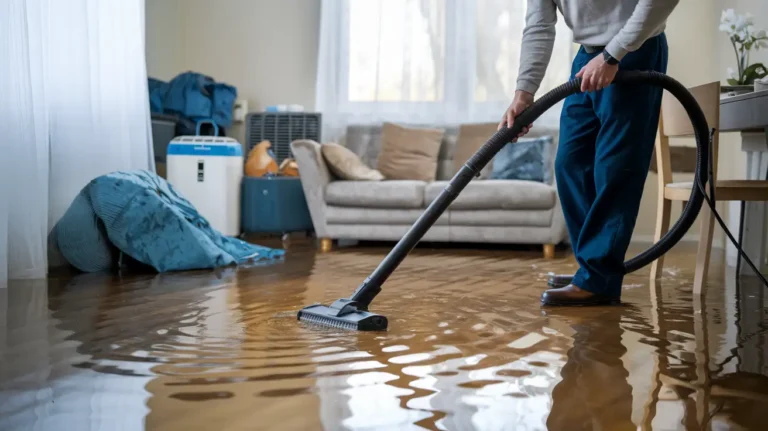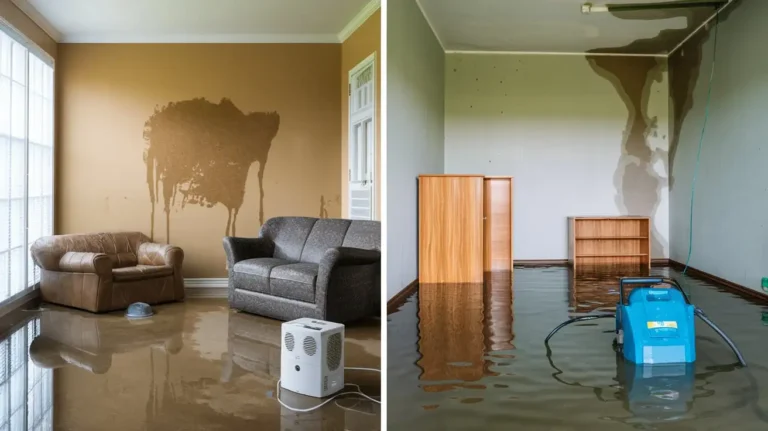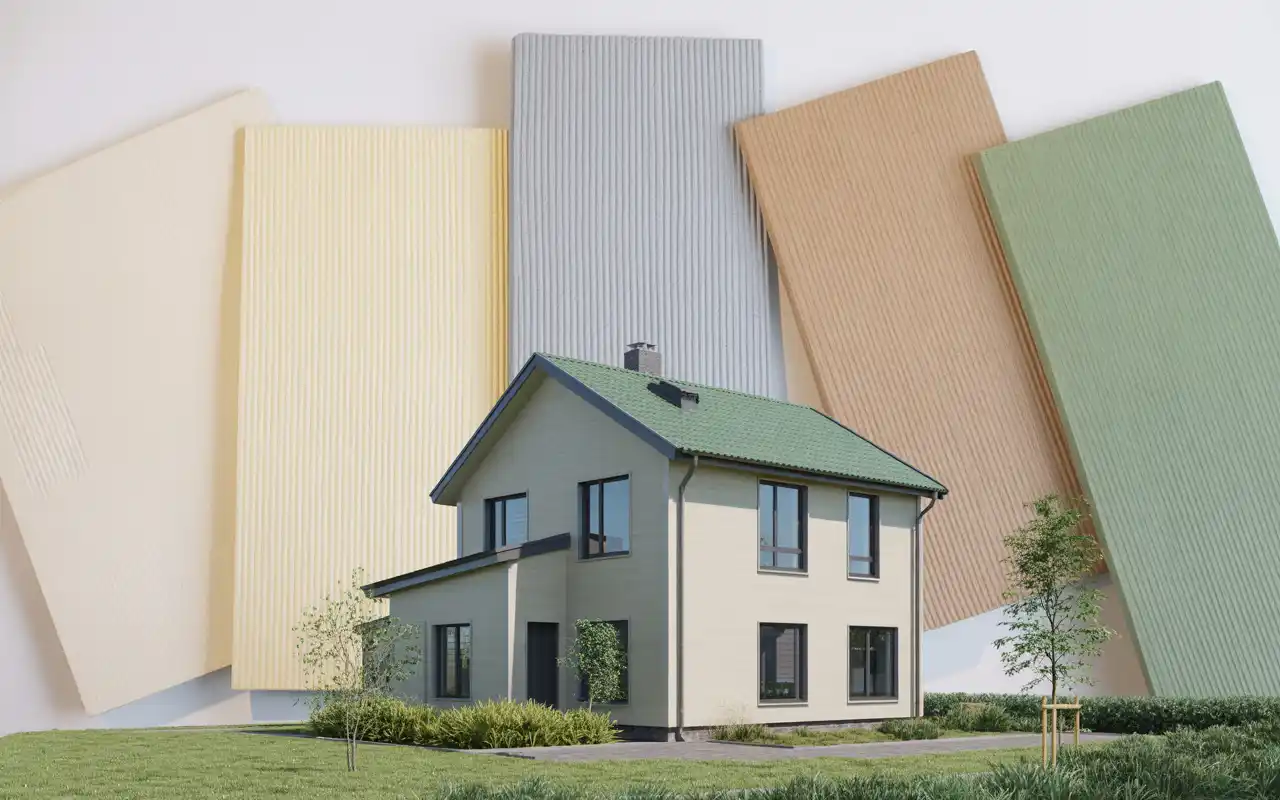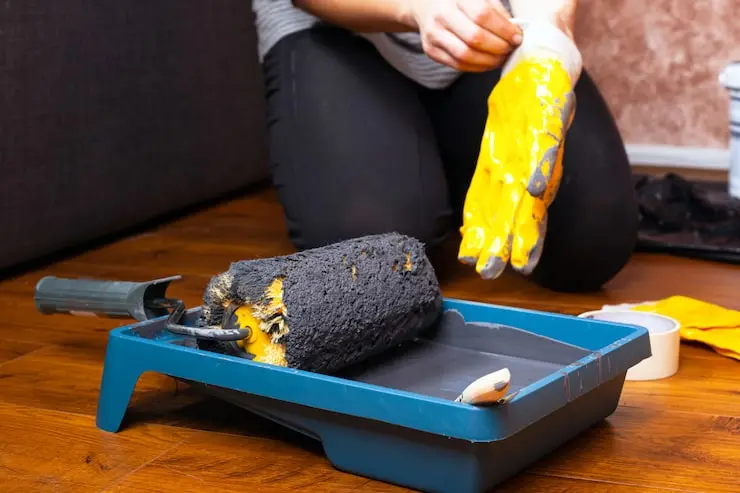Understanding water mitigation vs water restoration can save you thousands of dollars and weeks of stress. Mitigation stops the damage from spreading in the first 24-72 hours. Restoration fixes what’s already broken after everything is dry and stable.
Here’s the truth: most homeowners need both services, but mitigation always comes first. Skip it, and you’ll pay 3-4 times more in restoration costs. We’ve seen it happen across San Diego for over 23 years.
Table of Contents
What Is Water Damage Mitigation?

Water damage mitigation means stopping water from causing more destruction to your property. Think of it as an emergency response for your home.
When a pipe bursts at 2 AM or your roof leaks during a storm, mitigation teams jump into action. Their job isn’t to fix your home. It’s to prevent a bad situation from becoming a disaster.
The Mitigation Process: First 72 Hours
Hour 1-4: Emergency Response
- Locate and stop the water source (shut off main valve, patch roof, seal windows)
- Document damage with photos for insurance
- Extract standing water with pumps and vacuums
- Remove soaked materials that can’t be saved
Day 1-3: Structural Drying
- Set up industrial fans and dehumidifiers
- Use thermal imaging cameras to find hidden moisture
- Monitor moisture levels in walls, floors, and ceilings
- Apply antimicrobial treatments to prevent mold growth
Day 3-7: Final Assessment
- Test all areas with moisture meters
- Ensure humidity levels return to normal (30-50%)
- Remove drying equipment
- Create detailed report for restoration planning
Equipment Used in Water Mitigation Services
Professional teams use specialized tools you can’t rent at Home Depot:
- Moisture Meters: Detect water trapped inside walls without tearing them open. These save thousands by showing exactly what needs replacing.
- Thermal Imaging Cameras: Reveal cold spots where water hides. Wet areas show up as different colors on the screen.
- Commercial Dehumidifiers: Remove 50-100 gallons of moisture per day. Your home dehumidifier removes maybe 2 gallons.
- Air Movers: Industrial fans that dry 10 times faster than box fans. They create airflow patterns that reach every surface.
What Water Mitigation Costs
Mitigation typically runs $2,000-$7,000 depending on damage severity. Here’s the breakdown:
- Minor leak (one room, clean water): $2,000-$3,500
- Moderate damage (multiple rooms, some structural): $3,500-$5,500
- Major flooding (whole floor, contaminated water): $5,500-$12,000+
Most homeowner insurance policies cover mitigation costs. You’ll pay your deductible, usually $500-$2,500.
Understanding Water Categories
Not all water damage is equal. The source determines cleanup approach:
Category 1 (Clean Water): From supply lines, rain, or melting snow. Safe to handle with basic precautions. Examples include burst pipes or leaking faucets.
Category 2 (Gray Water): From dishwashers, washing machines, or toilet tanks. Contains bacteria. Requires professional cleaning and disinfecting.
Category 3 (Black Water): From sewage, flooding rivers, or standing water over 48 hours. Highly contaminated. Anything it touches usually gets replaced, not restored.
San Diego homes near the coast often deal with Category 2 water due to high humidity mixing with existing moisture issues.
What Is Water Damage Restoration?

Water damage restoration rebuilds what mitigation protects. This is where your home actually gets fixed.
Restoration doesn’t start until mitigation is complete. Trying to paint drywall while it’s still wet? You’ll be repainting in three months when mold appears.
The Restoration Process: What Actually Happens
Week 1-2: Damage Assessment & Planning
- Insurance adjuster visits and approves scope of work
- Restoration company creates detailed repair plan
- Order materials (drywall, flooring, insulation)
- Schedule timeline with homeowner
Week 2-4: Demolition & Repairs
- Remove damaged drywall, insulation, and flooring
- Check for hidden mold behind walls
- Replace structural elements if needed
- Install new insulation and vapor barriers
Week 4-6: Reconstruction
- Hang and finish new drywall
- Install new flooring (carpet, hardwood, tile)
- Paint walls and ceilings
- Reinstall baseboards and trim
Week 6-8: Final Details
- Deep clean entire affected area
- Test air quality for mold spores
- Walk through with homeowner
- Complete final insurance paperwork
What Restoration Services Include
Professional restoration companies handle:
- Structural Repairs: Replacing floor joists, wall studs, or ceiling beams damaged by water
- Mold Remediation: Removing all traces of mold and treating areas to prevent future growth
- Flooring Replacement: Installing new carpet, hardwood, laminate, or tile
- Drywall Work: Cutting out damaged sections and matching existing textures
- Painting: Color matching and finishing all repaired areas
- Deep Cleaning: Sanitizing and deodorizing to remove any musty smells
Restoration Costs: Real Numbers
Restoration typically costs 2-3 times more than mitigation. Here’s what to expect:
- Single room (bedroom, bathroom): $5,000-$12,000
- Multiple rooms (kitchen plus living areas): $12,000-$30,000
- Whole floor (basement or first floor): $30,000-$75,000+
- Structural damage (foundation, framing): Add 30-50% to above costs
Insurance usually covers restoration if you filed a claim during mitigation. Your policy might have limits on certain items like hardwood floors or custom tilework.
San Diego-Specific Restoration Challenges
Working on homes in San Diego for 23 years taught us a few things:
- Older Homes (built before 1980): Often lack proper vapor barriers. We add them during restoration to prevent future moisture problems.
- Coastal Properties: Salt air accelerates corrosion. We use marine-grade fasteners and moisture-resistant materials within 5 miles of the ocean.
- Stucco Exteriors: Common in San Diego but tricky with water damage. We check behind stucco for hidden rot that others miss.
- Spanish Tile Roofs: Beautiful but heavy. Water damage to roof framing requires engineering approval before restoration.
Key Differences Between Water Mitigation and Water Restoration

Aspect | Mitigation | Restoration |
Timing | First 24-72 hours | After mitigation ends |
Goal | Stop damage from spreading | Repair and rebuild |
Duration | 3-7 days typically | 2-8 weeks average |
Cost Range | $2,000-$12,000 | $5,000-$75,000+ |
Insurance | Almost always covered | Covered with approved claim |
Urgency | Immediate emergency | Scheduled project |
Result | Dry, stable structure | Finished, livable space |
The biggest difference? Mitigation is defensive. Restoration is reconstructive. You can’t skip mitigation and jump to restoration. The home needs to be dry first.
When You Need Both Services
Most water damage situations require both mitigation and restoration:
- Burst pipes that flood multiple rooms
- Roof leaks that damage ceilings and walls
- Appliance failures (dishwasher, water heater)
- Storm damage from heavy rain
- Sewage backups
Small issues might only need mitigation. A tiny leak caught early and dried quickly might not require any restoration.
Common Misconceptions About Water Restoration And Mitigation
“I Can Dry It Myself With Fans”
Home fans can’t create the airflow needed for proper drying. You might dry the surface, but moisture stays trapped in walls and under floors. Three weeks later, you’ll smell mold.
Professional drying equipment moves 10 times more air. It also monitors humidity levels to confirm everything is actually dry, not just feeling dry.
“My Carpet Will Dry on Its Own”
Carpet might dry. The padding underneath won’t. Neither will the subfloor beneath that. Wet subfloor causes:
- Mold growth within 48 hours
- Wood rot within 2-3 weeks
- Structural damage within months
- Health problems from spores in the air
We pull carpet, assess padding and subfloor, then decide what can be saved. Usually the carpet survives. Padding almost never does.
“Restoration Costs More Than Replacement”
Sometimes true for individual items. But for your whole home? Professional restoration usually costs 40-60% less than full replacement.
Experienced restoration companies know what can be saved. They also work directly with insurance companies to get proper coverage approved. DIY attempts often void insurance coverage.
“I Should Wait to See How Bad It Gets”
Water damage gets worse every single hour. Here’s the timeline:
- Hours 1-24: Water spreads through porous materials
- Hours 24-48: Mold starts growing
- Days 2-7: Structural materials begin warping
- Week 2+: Permanent damage sets in
Call for help within the first 24 hours. Every hour of delay adds to both damage and cost.
“Insurance Won’t Cover This”
Most homeowner policies cover sudden, accidental water damage. That includes burst pipes, appliance failures, and roof leaks from storms.
What insurance typically doesn’t cover:
- Gradual leaks you knew about but ignored
- Flooding from outside sources (requires separate flood insurance)
- Poor maintenance (like a roof that’s been leaking for years)
- Sewer backups (often requires an add-on policy)
The key is filing your claim during mitigation, not months later during restoration.
Living During Water Damage Restoration
Nobody talks about this part, but it affects every homeowner dealing with water damage.
Can You Stay in Your Home?
Depends on the extent of damage:
Category 1 Damage (One Room): Usually yes. We section off the work area with plastic sheeting. You’ll hear fans running 24/7 during mitigation.
Category 2-3 Damage (Multiple Rooms): Maybe. If we’re working on bathrooms and kitchen, daily life gets difficult. Many families stay with relatives for 2-4 weeks.
Structural Damage: Probably not. If we’re replacing floor joists or dealing with mold remediation, the home isn’t safe to occupy.
Some insurance policies cover temporary housing. Ask your adjuster about “loss of use” or “additional living expenses” coverage.
What to Do While Waiting for Restoration
Between mitigation and restoration (usually 1-2 weeks), you’re in limbo. Here’s how to handle it:
- Document everything: Take photos of all damage before cleanup
- Save receipts: Keep records of hotels, meals, and temporary housing
- Communicate with insurance: Weekly check-ins keep claims moving
- Don’t throw anything away: Let the adjuster see damaged items first
- Get multiple estimates: Insurance might require 2-3 bids for large jobs
How to Choose a Water Mitigation and Restoration Company
Not all restoration companies are equal. Here’s what to look for:
Certifications That Matter
- IICRC Certified: Industry standard for water damage restoration
- Licensed Contractor: Required for any work over $500 in California
- Insured: Minimum $1M liability coverage
- Bonded: Protects you if the company fails to complete work
Questions to Ask Before Hiring
- “How quickly can you respond?” (Answer should be within 2-4 hours)
- “Do you work directly with insurance companies?” (Should be yes)
- “What’s included in your estimate?” (Get itemized breakdown)
- “How long will the project take?” (Get specific timeline)
- “Can I see examples of similar projects?” (Photos or references)
Red Flags to Avoid
- Asking for full payment upfront
- No physical business address
- Can’t provide proof of insurance
- Pressure to sign contracts immediately
- Estimates much lower than competitors (usually missing services)
Call the Experts at San Diego Home Remodeling to Deal With Water Damage on Your Property
When water damage strikes your San Diego home, you need a team that understands local building codes, coastal moisture issues, and insurance requirements.
San Diego Home Remodeling has handled water damage restoration in San Diego for over 23 years. We’ve seen everything from minor pipe leaks to major storm flooding. Our team responds 24/7 because we know water damage doesn’t wait for business hours.
Why Choose Us for Water Damage Restoration in San Diego
- 24/7 Emergency Response: We answer calls day or night, weekends and holidays
- Licensed & IICRC Certified: Fully qualified for all mitigation and restoration work
- Direct Insurance Billing: We handle paperwork and communicate with your adjuster
- Local Expertise: We understand San Diego’s unique challenges (coastal moisture, stucco, older homes)
- Complete Service: From initial water extraction to final paint touch-ups
We serve all of San Diego County, including coastal communities where salt air creates unique restoration challenges.
Call us at 619 206 7590 or visit our Water Damage Restoration in San Diego page to learn more about our emergency services.
Frequently Asked Questions
How long does water mitigation take?
Most mitigation projects take 3-7 days. Small leaks might dry in 3 days. Major flooding can take up to 10 days to fully dry and stabilize.
Can I do water mitigation myself?
Small leaks caught immediately? Maybe. But professional equipment dries 10 times faster and prevents hidden moisture problems. Insurance companies often require professional documentation to approve restoration claims.
What's the difference between mitigation and remediation?
Mitigation prevents further damage. Remediation removes contaminants like mold or sewage. You might need both if Category 3 water (sewage) is involved.
Will my insurance cover both mitigation and restoration?
Usually yes, if the damage is sudden and accidental. You’ll pay one deductible that covers both phases. Gradual damage from neglected maintenance typically isn’t covered.
How much does water damage restoration cost in San Diego?
Costs range from $5,000 for a single room to $75,000+ for whole-floor restoration. Location affects pricing. Coastal properties often cost 15-20% more due to moisture challenges and marine-grade materials.
When should I start the restoration process?
Start restoration only after mitigation is complete and all areas are fully dry. This usually means 1-2 weeks after the initial water damage. Rushing into restoration while materials are still damp guarantees mold problems.
Do I need to move out during restoration?
Depends on severity. Single-room projects usually don’t require moving. Whole-floor restoration or mold remediation often does. Your insurance policy may cover temporary housing costs.
How do I prevent mold growth after water damage?
Professional mitigation is the best prevention. Teams dry your home within 48 hours, before mold can establish. They also apply antimicrobial treatments to vulnerable areas.







